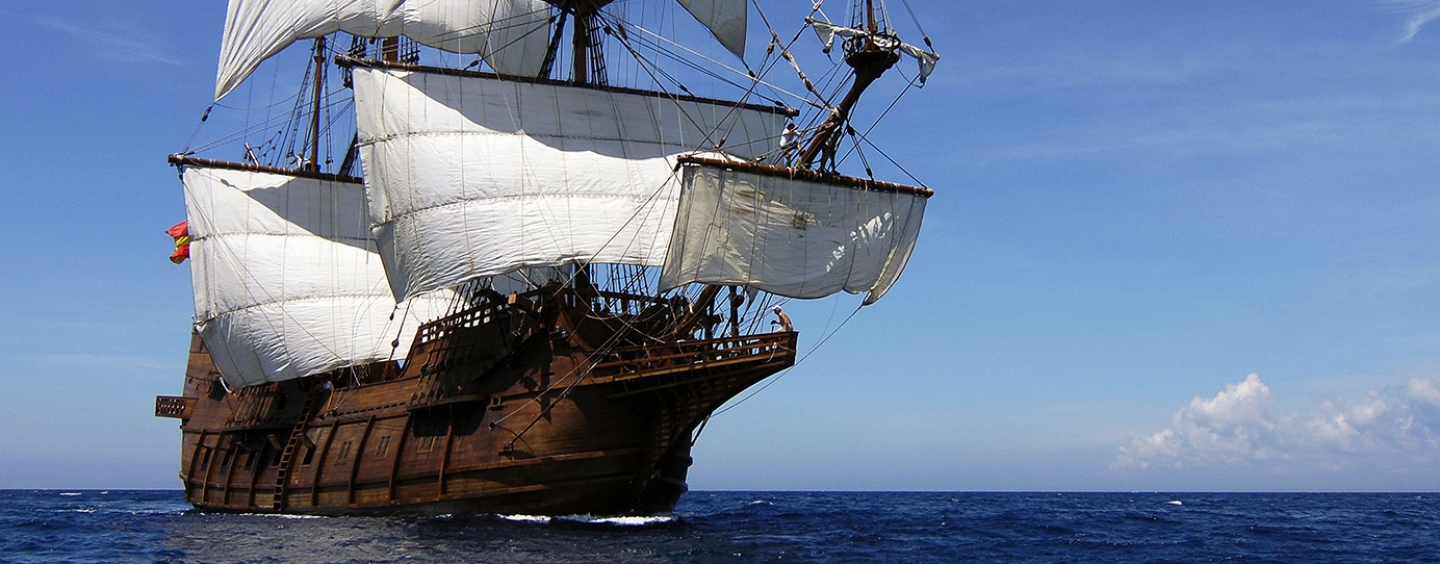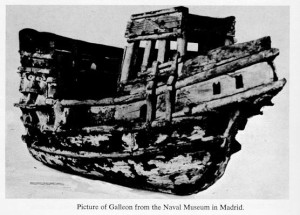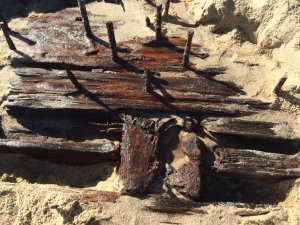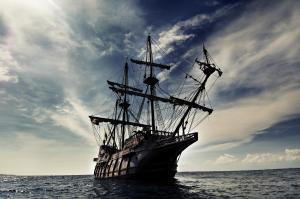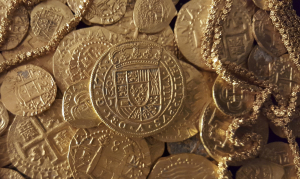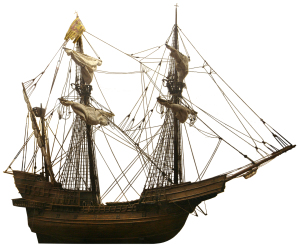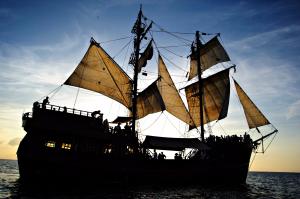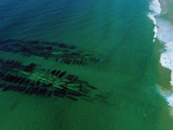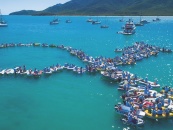“Is it a lost Portuguese or Spanish exploration ship, a caravel or carrack? Or is it the wreck a Mexican treasure galleon, a Manila Galleon, carrying millions of pesos in silver and gold coins, shipwrecked on Australia’s Queensland coast?” (www.unexplainedaustralia.com)
Under the peat of the 18 Mile Swamp on North Stradbroke Island, Queensland, lie the remains of a mysterious shipwreck built of European oak, known as the Stradbroke Island Galleon.
There exists a body of Aboriginal oral history and several artefacts found in the sand dunes, including a Spanish silver coin from 1597 and the blade of a 17th-century Spanish rapier. Some say it is merely folklore, while others swear a trail of historic artefacts, written reports, and anecdotal evidence are clear evidence of a 15th or 16th Century shipwreck. But there is yet no conclusive evidence.
In the 19th century, a few whites and certain Stradbroke Aborigines knew of the shipwreck’s exact location. But over the years, this important historic knowledge has been lost. Stradbroke oral history says that the shipwreck was a Spanish expedition ship exploring the edges of their Pacific domain. Marooned as the result of an “ancient storm”, the survivors of the shipwreck were helped by the Stradbroke Island Aborigines and, unable to return to Spain or Manila (Philippines), the shipwrecked Spanish sailors were absorbed by Stradbroke’s Aboriginal population. There are also suggestions that some North Stradbroke Island families are direct descendants of the shipwrecked sailors.
Since the British settlement of Australia, a number stories about mysterious pre-Captain Cook shipwrecks in Queensland have circulated, and a number of prominent Australian historians have questioned the claim that Captain Cook was the first European to discover Queensland. There is historic evidence that Captain Cook used Portuguese or Spanish maps such as recalled in the Dauphin, Dieppe, Vallard and Desceliers maps to aid his navigation of the Pacific and Australia’s east coast. The final answers to these important historic questions are likely to be found in the shipwreck still preserved in the peat moss of the 18 Mile Swamp.
The legend of the Stradbroke Island Galleon has polarised the archaeological fraternity for years. But a new search may soon begin for the long-lost shipwreck, which some say will rewrite Australia’s history books. The main bone of contention is not so much the existence of a wreck, but claims it could pre-date the east coast discoveries of Captain James Cook – that he was not in fact the first person to chart the Queensland coastline.
Lost Treasure?
No matter which side of the fence you sit, the story of “the ship in the swamp” on North Stradbroke certainly does get tongues wagging — and sparks questions about a long-lost treasure.
If it is a Manila galleon or a V.O.C. ship (which stands for Vereenigde Oost-Indische Compagnie [United East India Company], the largest commercial enterprise in the world, with a fleet of more than a hundred ships, thousands of employees, dozens of offices in Asia, and six establishments in the Netherlands in the 17th and 18th centuries), there may be truth to the Stradbroke Island oral history of a vast treasure buried somewhere on the island, its location known by certain Stradbroke Aboriginal elders.
Redland City Council have warned weekend treasure hunters to stay away from the island. “We don’t need amateur archaeologists traipsing through the swamp – leave it to the professionals.”
The fact so many people are likely to have visited the site – timber-getters, would-be explorers, treasure-hunters, politicians and, of course, the North Stradbroke Island Quandamooka people themselves – the existence of a long-lost treasure is unlikely.
Fact and fiction
One university professor, Greg Jefferys, had dedicated “a lot of time and effort” refuting and even ridiculing his own exhaustive research that began in 1989, best detailed in his book, The Stradbroke Island Galleon – The Mystery of the Ship in the Swamp. However, there has been no serious research to determine whether pre-Cook landings were indeed fact or fiction.
There have been several unsuccessful attempts to find the wreck in the last century. The last well-documented sightings of the wreck were in the 1890s and in 1934. In the 1890s, before the Jumpinpin breakthrough, Matthew Heeb, a shipwright and a timber-getter, saw the shipwreck and described it as a “vessel with a high poop and forecastle”. In 1934, Jim Walker, a sailor and son of a boat builder, and two friends found the shipwreck, after a fire had burnt through the 18 Mile Swamp during a drought.
Many artefacts found are said to be directly linked to the Spanish/Portuguese Galleon – a bronze walking stick handle, a sailor’s dirk, ceramic bowl, a ship’s brass bell, and doubloons used by Aboriginal people to trade for European goods in the 1920s-30s. There are also historic records of people being shown the wreck, and anecdotal evidence of people who claimed to have seen and taken items of historical significance, including brass and copper fittings.
One lady, insisting on anonymity, is one of many North Stradbroke Indigenous residents. She said that she had heard of a wooden box “containing coins, books, a belt buckle, a couple of rings and other items”, and had been handed down through generations but was lost in a house fire at Dunwich in the 1980s. She recounted her family heritage so it would not be lost with the passing of her generation, but was unwilling to go on the record.
But to prove Jefferys’ theory and again rattle the archaeological “establishment” would be worth just as much as a chest full of gold coins for Jefferys’ dedicated team, including Capalaba GP Dr Cliff Rosendahl PhD and maritime engineer Brad Horton.
Visit www.stradbrokeislandgalleon.com for a wealth of information on the mysterious shipwreck.
Compiled by: Southport Yacht Club’s Maritime Heritage Ship Wreck Committee
(Editor’s Note: Here’s an interesting point that has been written about Jefferys’ book: “The book is the result of extensive research into early Australian and Queensland maritime history and archaeology and uses many local and international historic resources including extensive investigation of Spanish maritime histories and historians including noted Spanish historian Professor Francisco Mellen, an expert on the history of the Pacific. Most of these non-Anglo Saxon history resource are either deliberately ignored or casually overlooked by ‘establishment’ archaeologists and historians, defending the British biased status quo of Australian history that Cook, not the Spanish or Portuguese, were the first Europeans to discover Australia despite a mounting body of historic and archaeological evidence to the contrary.” [stradbrokeislandgalleon.com])
(Feb-Apr2017)






















